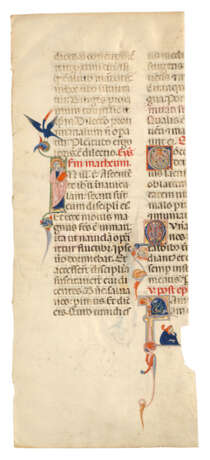ID 381206
Los 1 | Anonymous Umbrian artist working in Rome
Schätzwert
£ 3 000 – 5 000
A fragment from a sumptuosly illuminated 13th-century Italian Bible likely made for the Basilica of St Praxedes in Rome.
365 x 145mm. A fragment of a leaf, two columns of 25 lines, the text with readings from the Gospel of Matthew and for the Fifth Sunday after Epiphany, two historiated initials and three illuminated initials, one with a seated figure. Provenance: Four other leaves from the same manuscript are known: two previously in the collection of the famous antiquarian Bernard Breslauer (offered at Christie's, London, 11 December 2002, lots 4 and 5, see also W.Voelkle and R. Wieck, The Bernard Breslauer Collection of Art. Manuscript Illuminations, 1992, pp.161-163) and two further leaves in the private collection offered at Koller Auctions, Zurich, 18 September 2015 (see lot 109). G Freuler puts forward the possibility, on the basis of the emphasis accorded to St Praxedes in one of the surviving leaves, that the parent manuscript was produced in Rome, perhaps even for the Basilica of St Praxedes itself.
Illumination: The stylised heads, with features sparsely described in fleshtone over grey underpaint and hair represented as strands of concentric strokes, manage to convey both pattern and volume. The sinuous and taut confidence of line - with leaf terminals springing and twisting back on themselves - is combined to very decorative effect with a clear, light palette for figures and forms set against backgrounds of highly reflective gold. Execution is precise and delicate. In spite of the distinctive and high quality of the illumination it is difficult to localise the centre where the parent manuscript was produced: some of the subsidiary elements - such as the flourish initials and the penwork decoration in the grounds of the initials - can be paralleled in Perugian manuscripts of the final quarter of the thirteenth century - and Perugian illumination is often characterised by the delicacy and fluidity of its decoration: see M.M. Manion and V.F. Vines, Medieval and Renaissance Illuminated Manuscripts in Australian Collections, 1984, pp.28, 37-39, and F. Avril and M.-T. Gousset, Manuscrits enluminés d'origine italienne, 2: XIIIe siècle, 1984, pp.119-122. Freuler, in his cataloguing of the Koller leaf, acknowledges the Umbrian link, especially in the palmette extensions, which find parallels in early illumination in Perugia. The liturgical link to the cult of St Praxides, though, makes it likely that our illuminator was working in Rome, and comparisons can be drawn with the work of the artist in a Pontifical made for San Giovanni in Laterano (Paris, BnF, Ms. Lat. 960).
| Adresse der Versteigerung |
CHRISTIE'S 8 King Street, St. James's SW1Y 6QT London Vereinigtes Königreich | |
|---|---|---|
| Vorschau |
| |
| Telefon | +44 (0)20 7839 9060 | |
| Aufgeld | see on Website | |
| Nutzungsbedingungen | Nutzungsbedingungen |



